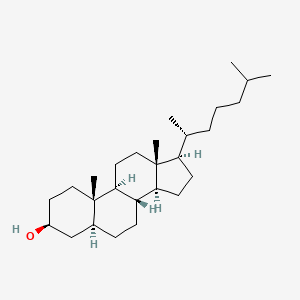| MeSH term | MeSH ID | Detail |
|---|---|---|
| Diabetes Mellitus | D003920 | 90 associated lipids |
| Diabetes Mellitus, Type 2 | D003924 | 87 associated lipids |
| Cataract | D002386 | 34 associated lipids |
| Hypercholesterolemia | D006937 | 91 associated lipids |
| Alcoholism | D000437 | 27 associated lipids |
| Brain Diseases, Metabolic | D001928 | 9 associated lipids |
| Biliary Fistula | D001658 | 13 associated lipids |
| Xanthomatosis | D014973 | 17 associated lipids |
| Xanthomatosis, Cerebrotendinous | D019294 | 14 associated lipids |
Dihydrocholesterol
Dihydrocholesterol is a lipid of Sterol Lipids (ST) class. Dihydrocholesterol is associated with abnormalities such as Exanthema, Morphologically altered structure, protrusion, Dehydration and Xanthoma. The involved functions are known as Regulation, Biochemical Pathway, Methylation, Metabolic Inhibition and Biosynthetic Pathways. Dihydrocholesterol often locates in envelope, Mitochondria, Lipid Bilayers, Host Cell and Membrane. The associated genes with Dihydrocholesterol are GRAP2 gene, PTP4A2 gene, HSD3B7 gene, MBD2 gene and IGF2BP3 gene. The related lipids are Sterols, Cardiolipins, Pregnanes, 7-hydroxy-4-cholesten-3-one and Hydroxycholesterols. The related experimental models are Mouse Model.
Cross Reference
Introduction
To understand associated biological information of Dihydrocholesterol, we collected biological information of abnormalities, associated pathways, cellular/molecular locations, biological functions, related genes/proteins, lipids and common seen animal/experimental models with organized paragraphs from literatures.
What diseases are associated with Dihydrocholesterol?
Dihydrocholesterol is suspected in Xanthoma, Xanthomatosis, Cerebrotendinous, Coronary heart disease, Exanthema, Morphologically altered structure, Dehydration and other diseases in descending order of the highest number of associated sentences.
Related references are mostly published in these journals:
| Disease | Cross reference | Weighted score | Related literature |
|---|
Possible diseases from mapped MeSH terms on references
We collected disease MeSH terms mapped to the references associated with Dihydrocholesterol
PubChem Associated disorders and diseases
What pathways are associated with Dihydrocholesterol
There are no associated biomedical information in the current reference collection.
PubChem Biomolecular Interactions and Pathways
Link to PubChem Biomolecular Interactions and PathwaysWhat cellular locations are associated with Dihydrocholesterol?
Visualization in cellular structure
Associated locations are in red color. Not associated locations are in black.
Related references are published most in these journals:
| Location | Cross reference | Weighted score | Related literatures |
|---|
What functions are associated with Dihydrocholesterol?
Related references are published most in these journals:
| Function | Cross reference | Weighted score | Related literatures |
|---|
What lipids are associated with Dihydrocholesterol?
Related references are published most in these journals:
| Lipid concept | Cross reference | Weighted score | Related literatures |
|---|
What genes are associated with Dihydrocholesterol?
Related references are published most in these journals:
| Gene | Cross reference | Weighted score | Related literatures |
|---|
What common seen animal models are associated with Dihydrocholesterol?
Mouse Model
Mouse Model are used in the study 'On the mechanism of accumulation of cholestanol in the brain of mice with a disruption of sterol 27-hydroxylase.' (BÃ¥vner A et al., 2010).
Related references are published most in these journals:
| Model | Cross reference | Weighted score | Related literatures |
|---|
NCBI Entrez Crosslinks
All references with Dihydrocholesterol
Download all related citations| Authors | Title | Published | Journal | PubMed Link |
|---|---|---|---|---|
| Fleck JD et al. | Neuroimages: cerebrotendinous xanthomatosis. | 2000 | Neurology | pmid:10953208 |
| Watne AL and Core SK | Fecal steroids in polyposis coli and ileorectostomy patients. | 1975 | J. Surg. Res. | pmid:1100901 |
| Kraaipoel RJ et al. | Incorporation of H2 18O into 20alpha, 22R-di-OH cholesterol: evidence for an epoxide-diol pathway in the adrenocortical cholesterol side-chain cleavage mechanism. | 1975 | FEBS Lett. | pmid:1102334 |
| Snider BB et al. | Letter: Removal of the steroid side chain using remote oxidation. Conversion of 3beta-cholestranol to androsterone acetate. | 1975 | J. Am. Chem. Soc. | pmid:1102590 |
| Radhakrishnan A et al. | Condensed complexes, rafts, and the chemical activity of cholesterol in membranes. | 2000 | Proc. Natl. Acad. Sci. U.S.A. | pmid:11050164 |
| Böttcher MF et al. | Microflora-associated characteristics in faeces from allergic and nonallergic infants. | 2000 | Clin. Exp. Allergy | pmid:11069568 |
| Yan JL et al. | Microbial transformation of 3-hydroxy-5,6-cyclopropanocholestanes--an alternative route to 6-methylsteroids. | 2000 | Steroids | pmid:11077084 |
| Eganhouse RP and Sherblom PM | Anthropogenic organic contaminants in the effluent of a combined sewer overflow: impact on Boston Harbor. | 2001 | Mar. Environ. Res. | pmid:11125703 |
| Burnett JR et al. | Clinical and biochemical features, molecular diagnosis and long-term management of a case of cerebrotendinous xanthomatosis. | 2001 | Clin. Chim. Acta | pmid:11282095 |
| Inoue K et al. | [Cerebrotendinous xanthomatosis]. | 2001 | Nippon Rinsho | pmid:11347094 |
